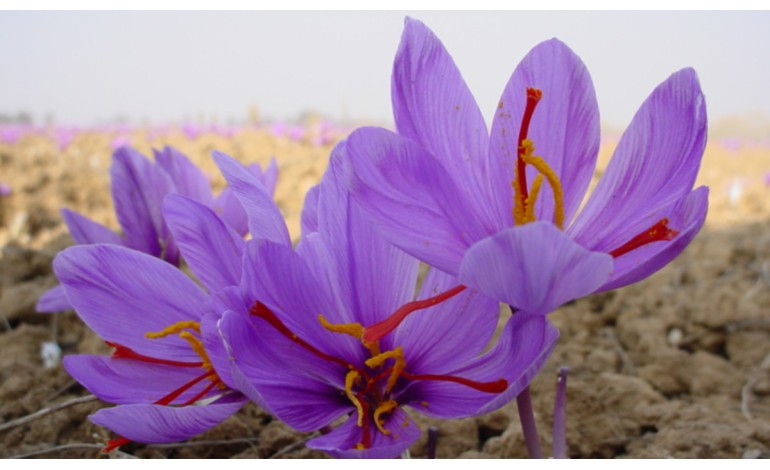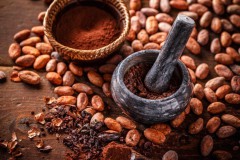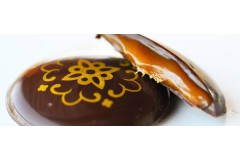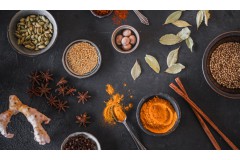cultivated for over 3000 years, the saffron is of Greek origin, the crest more precisely.
Descendant of the wild crocus, the crocus cartwrightianus , the crocus sativus was recognized for its long pistils and was then cultivated. The spice represents the pistil of the flower.
The Crocus Sativus is a bulb plant that gives birth to a purple flower during the fall. It is a plant whose cycle is reversed to others: it flowers in autumn, develops in winter and then the plant divests in the spring to disappear in the first heat. The underground bulb will remain in vegetative rest until its next new cycle. This is one of the oldest cultivated spices.
Since its cultivation in Greece, the saffron has first spread over the Mediterranean perimeter and then in the East (Persian, Asia) and West. In Europe it was the Moors who introduced him back from Spain to France. They left their know-how in the Mancha region in Spain (today Safran Aop la Mancha) and in France in particular, in Quercy and the Albigensian in 732.
the most expensive food in the world, but not in its use
The picking of saffron turns out to be a long -term job: At dawn, you have to pick the flowers one by one, delicately take the pistil and so on throughout flowering (4 to 6 weeks). It is this work that makes the price of one kilo so dearly, it is indeed necessary to swallow approximately 150000-200000 flowers to obtain a kilo of saffron.
However, the price per kilo is not a good landmark, it is only used for media coverage, because it impresses. Are you looking at the price of the ton of wheat if you buy a packet of flour? No.
It must be reduced to its proportion of use. There are about 1 pistil, three stigmata per person. This significantly reduces its cost, about 50 to 60 cents per dish. ; Compared, it is much more expensive to make a dish with a vanilla pod.
the most falsified spice in the world:
Since its cultivation, saffron has been the most falsified spice in the world. Pliny the old, renowned Roman naturalist, already said that "adultsratur nihil aque", there was nothing more falsified.
In the 14th century, the city of Nuremberg in Germany was the hub for saffron trade (and spices). Be protecting the authenticity of saffron, the Safranschau code was imposed. It was a code containing specific standards for saffron but also punishment in the event of fraud. The fraud penalties were severe because the code authorized civil servants to imprison or execute people guilty of fraud as well as their accomplices.
In France, repressive measures were also taken in case of falsification. The edict of King Henri II, dating from March 18, 1550, presented rules to defend the saffron and punish his falsification in the famous fairs of Lyon. He ordered the confiscation of the improper goods and its destruction by fire with heavy fines for offenders
Today the fraud still exist, they are even legions.
Two types of fraud are listed:
substitution products:
either by changing the appearance with resembling substitution products; Such as flowers of concern, carthame, corn beard, etc. either, in the case of ground saffron, adding paprika, turmeric, brick dust, etc ...
Safran increase techniques:
Another technique aims to increase the weight of the saffron with different elements: water to rehydrate it, honey, oil, leaving the style (yellow part of the base of the pistil, having little taste )
So how to recognize a real saffron?
First of all, you have to completely exclude the purchase of saffron powder. You can never be on if the powder contains only saffron. Always take raw saffron in pistils.
If we know the shape of the pistil and therefore of the stigma of a saffron, you will have no problem recognizing it. The stigma is purple red and is slightly flared at its top.
pistil, stigma What is the difference? The flower provides a pistil that consists of 3 small branches called stigma.
A very simple technique then allows you to recognize a real saffron: take one or two stigmata, place them on a sheet of white paper. Moisten your finger and move the stigma by pressing the sheet slightly, you will immediately see that the stigma colors the sheet in orange yellow clearly and frankly. It’s saffron.
All other colors (brown, red, purple, etc.) will indicate a falsified product.
Also check if the crocine, picrocrocine and safranal rates are displayed, they demonstrate that saffron has been analyzed.
standards to qualify it and fight fraud:
Since 1993 there are ISO standards that help fight fraud and help recognize quality saffron producers. Saffron is considered pure when it complies with the requirements set in ISO 3632 standard and no material has been added to the natural product.
In addition three chemical compounds are analyzed through this standard: the picrocrocine which gives the taste of saffron, the crocine for the color yellow-orange and the safranal, a volatile oil, which gives it its perfume.
The ISO 3632 standard establishes standard saffron categories. It offers four classes; From the weakest category IV to category I, the best. Safran samples are classified according to their concentration in picrocrocine, crocine and safranal, analyzes carried out in certified laboratories. The results make it possible to classify the Safrans by quality according to the table below:
our Afghanistan saffron
The Safran of Afghanistan is considered one of the best in the world. Our Afghanistan saffron is first of all the story of a woman, Karima. She set up her small saffron business in the province of Herat, in the northwest of Afghanistan. With a few kilos of saffron produced each year it is proud "to present to the world a positive image of Afghanistan".
Son saffron is a rare and exceptional product with its aromatic qualities. This is the best part of the saffron, only the purple and intense stigma. Large style , the yellow part that fixes the pistil at the base of the flower. This is called neguine saffron.
Why this saffron?
We chose it for three reasons: The first is that he has exceptional crocine (284), Picrocrocine (108) and Safranal (43) levels positioning him as a gastronomic saffron . The second is its aromatic expression: beyond the bitterness of saffron, for its almost "metallic" side, there is clearly over the suave aromatic notes of honey, raisins, prunes, prunes, dried straw, almost smoked. It is an aromatic product, ready to deliver all its flavors and perfumes.
Finally The third reason is the saffron of a human adventure. As a woman in an Afghan company conservative, the Karima path was not very easy in the creation of her business. Today we are happy to participate in the emancipation of Karima and his business.
How to use saffron?
The saffron is an infusion spice. It should not be used otherwise, at the risk of having little taste. Take lukewarm water and let your saffron infuse for 2 hours to release all its perfumes and aromas. Then use this infusion for your kitchen. Never use saffron with boiling water or in a simmer dish. Indeed, heat above 70 ° tends to destructure the aromatic compounds of your saffron (in particular the safranal responsible for its perfume). However, it is possible to infuse your saffron directly in a simmered dish: cut the heat, wait until the dish becomes lukewarm, add the pistils. Let infuse, then warm up to a service temperature.
Safran conservation
Like all other spices, although this is aesthetic, it should not be exposed to light. Keep your saffron in a small opaque box and keep it in a dry place out of humidity. The saffron can thus express all its power up to a year and a half or even two years.
Good day,
Max Daumin
The saffron is an infusion spice. It should not be used otherwise, at the risk of having little taste. Take lukewarm water and let your saffron infuse for 2 hours to release all its perfumes and aromas. Then use this infusion for your kitchen. Never use saffron with boiling water or in a simmer dish. Indeed, heat above 70 ° tends to destructure the aromatic compounds of your saffron (in particular the safranal responsible for its perfume). However, it is possible to infuse your saffron directly in a simmered dish: cut the heat, wait until the dish becomes lukewarm, add the pistils. Let infuse, then warm up to a service temperature.
Safran conservation
Like all other spices, although this is aesthetic, it should not be exposed to light. Keep your saffron in a small opaque box and keep it in a dry place out of humidity. The saffron can thus express all its power up to a year and a half or even two years.
Good day,
Max Daumin



